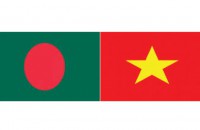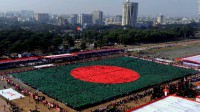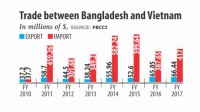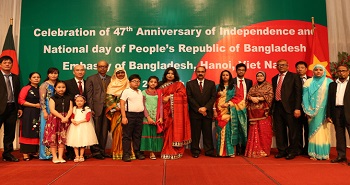-

Bangladesh targets $1b trade ties with Vietnam
-

VIETNAM COFFEE EXPORTS UNDER THE TOP 2 OF THE WORLD
-

Rice Exports by Country
-

Relations between Bangladesh and Vietnam
-

Bangladesh Economic Outlook 2019: A resilient economy in need of sound policy LIGHTCASTLE ANALYTICS WING
-

Bangladesh Economy Continues Robust Growth with Rising Exports and Remittances
-

Vietnam beats us in RMG for last 5 months in 2019
-

Bangladesh to seek more Vietnamese investment
VIETNAM COFFEE EXPORTS UNDER THE TOP 2 OF THE WORLD
.jpg)
Coffee is the third most consumed beverage globally, behind only water and tea. Coffee is not only used to make drinks, coffee beans (through decaffeination) also provide caffeine for other beverages (typically cola), in addition to pharmaceuticals and cosmetics. According to statistics of the International Coffee Organization, Vietnam is a country in the top 2 of the leading coffee producing countries in the world.
Although there are many different flavors, only two types of coffee are produced commercially, Arabica and Robusta. Each year, about 1 trillion cups of coffee are consumed around the world. That is why coffee is considered the second most traded commodity in the world after oil.
The leading coffee producing countries in the world have produced millions of tons of coffee beans and they are always looking for ways to bring them to the hands of millions of loyal consumers of coffee.
Below is a list of the top 10 coffee producing countries in the world:
10 Guatemala
Guatemala produced 204,000 tons of coffee in 2016, and its production has remained fairly stable over the past few years. Coffee grows in popularity throughout Guatemala throughout the year, where temperatures fluctuate between 16 and 32 ° C and with elevations between 500 and 5,000 meters above sea level, making it perfect for coffee. Favorable development. Guatemala was Central America’s leading producer until Honduras passed in 2011.
The original purpose of Guatemala entering the coffee playground was to find an export product that replaced indigo and cochineal, their first two export products, until chemical dyes were invented in the 1800s. At that time, the government started a policy of supporting the industry by providing commercial and tax benefits. In the 1960s, the Government constantly supported and promoted the worldwide demand for Guatemalan coffee through the establishment of Anacafé (Asociación Nacional del Café – the Asociación National Coffee Association), a marketing association. the coffee. To this day Guatemala is constantly promoting the nation’s coffee to the world.
9 Mexico
In 2016, Mexico produced more than 234,000 tons of green coffee. The country mainly produces high-quality Arabica coffee beans grown in coastal areas near the Guatemala border. Mexico is responsible for the majority of US coffee importers.
In the 1990s, there was a crisis in Mexican coffee production, when the International Coffee Agreement was lifted and world coffee prices and export quotas were no longer strictly controlled, leading to Mexico’s inability to compete in the global market. The decline in coffee and production prices has led to loss of income with social problems throughout Mexico. Although coffee production declined in the 1990s, by the 2000s, stable demand from the United States led to a recovery in Mexico’s coffee market, from 1.7 million bags (60 kg. / bag) in 2005, productivity increased to 4.0 million in 2014.
8 Uganda
Although Uganda may not stand out in the coffee industry, in 2016 it also produced 288,000 tons, making it the highest-income exporting country of Central Africa. Uganda overtook Mexico in 2015 to become the 8th largest coffee producer. The country grows both Robusta beans – a native crop in the Kibale forest area – as well as Arabica beans from Ethiopia near there.
Coffee is an important part of the Ugandan economy, with the majority of the population working in the coffee industry. Coffee production was initially an unsuccessful state-controlled area, however, after privatization of the government in 1991, there was a strong recovery of the industry, leading to an increase in 5100% production since 1989. However, the government continues to control the industry, with the outward flow controlled by the Uganda Coffee Development Authority.
7. India
While India may not be the first country to be mentioned in producing coffee, it produced 348,000 tons of coffee beans in 2016. Not every region of the country is appropriate. Suitable for coffee production, most of them are grown only in the hilly areas of the South Indian states. Coffee beans are grown in monsoon rains, often grown with spices like cardamom and cinnamon, giving the coffee a spicy taste and aroma. In 2004, Indian coffee brand Tata won three gold medals at the Grand Cus De Cafe Competition. Absolutely as expected, coffee is not the most popular beverage in the country with 1.25 billion people, the title for tea. Thus, 80% of India’s coffee production is for export purposes, with major buyers from Europe and Russia.
6. Honduras
Honduras made the leading coffee producing countries 279 279 kg of coffee in 2014, a significant reduction compared to the production of 354,180,000 kg in 2011. This decline has been attributed to the lack of branding. country – while most people recognize Colombian or Ethiopian coffee, coffee beans from Honduras are mostly used in blends and are therefore less identifiable from consumers. However, coffee remains an important part of the Honduran economy – the country is the largest producer in Central America, the coffee industry is constantly providing jobs and income to a large part of the population. number and it is likely to keep the nation’s economy prosperous in 2009 overcoming the political crisis in Honduras.
5. Ethiopia
Ethiopia produces large quantities of coffee each year, with 384,000 tonnes in 2016. Ethiopia is the geographical location of Arabica coffee, the most popular bean in the world. This is not a small part of the national economy – more than 28% of Ethiopia’s annual exports are from coffee – and an estimated 15 million people work in the coffee industry.
Ethiopia has a very rich coffee culture. For over 1100 years, the coffee bean has had the unfortunate effect of being recognized by farmers and shepherds across the country. Since the harvest of the crop and the beginning of coffee bean cultivation, regional variants of the Arabica bean have been developed, each with its own unique characteristics and flavor. Harar, Limu, Sidamo, and Yirgacheffe seeds are all Arabica coffee varieties, owned and protected by the Ethiopian government.
4. Indonesia
Although not a country known worldwide as one of the leading coffee producing countries, but in 2016 Indonesia still produced more than 660,000 tons of coffee in 2016. Indonesia has selected a number of methods. production methods of coffee beans are specifically aimed at the climate here. Low-quality Robusta is the staple commodity Indonesia chooses to produce, they are less valuable than Arabica coffee from countries like Brazil and Colombia.
Indonesia is famous for Kopi Luwak, an expensive coffee bean and a unique mode of production by ferrets.
Coffee production was carried out by the Dutch in Indonesia and production continued after colonization because the country’s climate was suitable for crops. Coffee plantation now occupies over 1 million hectares of Indonesia’s territory, with more than 90% of the arable land being worked by small-scale producers.
There is a famous and high quality Indonesian coffee called Kopi Luwak, an expensive coffee bean and a unique production method by ferrets living in the tropical forests of Southeast Asia, they eat pure berries but unable to digest the hard seeds inside which we call it green coffee. The ferrets’ digestive juices break down the outer layers of coffee beans and release indigestible hard particles mixed in mink droppings, which are then cleaned and sold as Kopi Luwak coffee. . Each year, only about 500kg of coffee is produced in Indonesia, a cup of coffee made from Kopi Luwak coffee beans can sell for up to $ 80.
3. Colombia
Colombian coffee is famous all over the world, perhaps in part because of the impressive advertisements of the National Agricultural Coffee Federation of Colombia with the positive contribution of a character named Juan Valdez. However, the climate in recent years has affected the production of coffee in Colombia. Between mid-1980 and 2010, temperatures rose rapidly, as did rainfall, both of the main factors hindering coffee bean production in Colombia. Even with the influence of the climate, Colombia still had a significant production of 810,000 tons of coffee in 2016, Colombia is still a serious test in the international coffee arena.
2. Vietnam
Vietnam is the second largest coffee producing country in the world – in 2016 alone, it produced 1,650,000 tons. Despite being interrupted by during and after the war in Vietnam, coffee is still a key production product of the Vietnamese economy, second only to rice. Vietnam quickly expanded coffee production in 1975 with only 6,000 tons / year and now nearly 2 million easily bring them to the national position as one of the world’s second leading coffee producing countries.
1. Brazil
Brazil is one of the leading coffee producing countries. In 2016, Brazil produced 2,590,000 tons of coffee. This result is not really surprising, because Brazil has become the most advanced coffee bean producer for more than 150 years.
Coffee plantations covering about 27,000 square kilometers of Brazil are mostly located in Minas Gerais, Sao Paulo and Parana, the three southeastern states, where the climate and temperature are ideal for coffee production. Brazil also creates its own distinctive feature compared to other coffee producing countries, in which Brazilian people process coffee with a dry process (unwashed coffee), which is exposed to the owner.
From many sources
- - Bangladesh targets $1b trade ties with Vietnam
- - Bangladesh to seek more Vietnamese investment
- - Relations between Bangladesh and Vietnam
- - Bangladesh Economic Outlook 2019: A resilient economy in need of sound policy LIGHTCASTLE ANALYTICS WING
- - Bangladesh Economy Continues Robust Growth with Rising Exports and Remittances
- - Rice Exports by Country
- - Vietnam beats us in RMG for last 5 months in 2019
- - Agri-food and horticulture in Vietnam
Copyrights Thiet Ke Website by ungdungviet.vn





